Physical Address
304 North Cardinal St.
Dorchester Center, MA 02124
Vascular anomalies represent a broad spectrum of disorders from the simple birthmark to the multisystem life-threatening disorder. Classically they have had a variable nomenclature that has promoted misdiagnosis and mistreatment. The modern movement in the field of vascular anomalies has been to create a uniform classification system based on the pathophysiology of these disorders, which also lends to understanding the individualized treatment regimen of each disorder. This chapter is structured around the 2018 International Society for the Study of Vascular Anomalies (ISSVA) classification of vascular anomalies. The system generally divides the study of vascular anomalies into vascular tumors and vascular malformations. Although this is an oversimplification of the classification system, it is a helpful starting point. First, attention will be turned to vascular tumors in an evaluation of the benign, locally aggressive, and malignant categories of this disorder. Next will be a description of the vascular malformation that divides into categories of simple (slow flow and fast flow), combined, and associated with other anomalies. The framework of these categories provides the system for defining and understanding the field of vascular anomalies.
Vascular tumors represent a grouping of vascular anomalies in which the vascular tissue is proliferating without appropriate regulation. The dysfunction in regulation often leads to rapid enlargement of the tissue with either compression or invasion of local structures. The spectrum of these disorders spans from the benign (hemangiomas and reactive vascular tumors) to the locally invasive or malignant tumor (kaposiform hemangioendothelioma [KHE] and angiosarcoma).
The infantile hemangioma is the second most common vascular anomaly, with an incidence of 4.5% in the general population and with a female predominance. The classic understanding of infantile hemangioma is a benign endothelial tumor that is usually absent at birth or present as a premonitory mark with rapid postnatal growth followed by slow involution. Infantile hemangiomas have varied presentations in quality, depth, location, size, and progression. These five areas also provide the key in clinically describing an infantile hemangioma.
First, quality starts with the differentiation of a localized hemangioma ( Fig. 10.1 ) in contrast to the segmental hemangioma ( Fig. 10.2 ). A localized hemangioma is an easily differentiated single hemangioma in which a clinician can define boundaries, whereas the segmental hemangioma appears as an island of plaque-like lesions in pseudodermatomal distribution. Second, depth describes the position of the infantile hemangioma within the epidermal/dermal composition. The classic descriptions are of superficial, deep, and mixed lesions. Superficial hemangiomas are often described as the “strawberry” hemangioma, a confluent red plaque that has the appearance that it can be plucked off the surface of the skin ( Fig. 10.3 ). The deep lesion on the other end of the spectrum appears as a swelling that may have a bluish discoloration on the surface but at times can be very difficult to differentiate from other soft tissue tumors by appearance alone ( Fig. 10.4 ). The final description would be the mixed lesion in which the infantile hemangioma has components both of superficial plaque and surrounding swelling ( Fig. 10.5 ). The mixed type is the most common presentation of infantile hemangiomas.
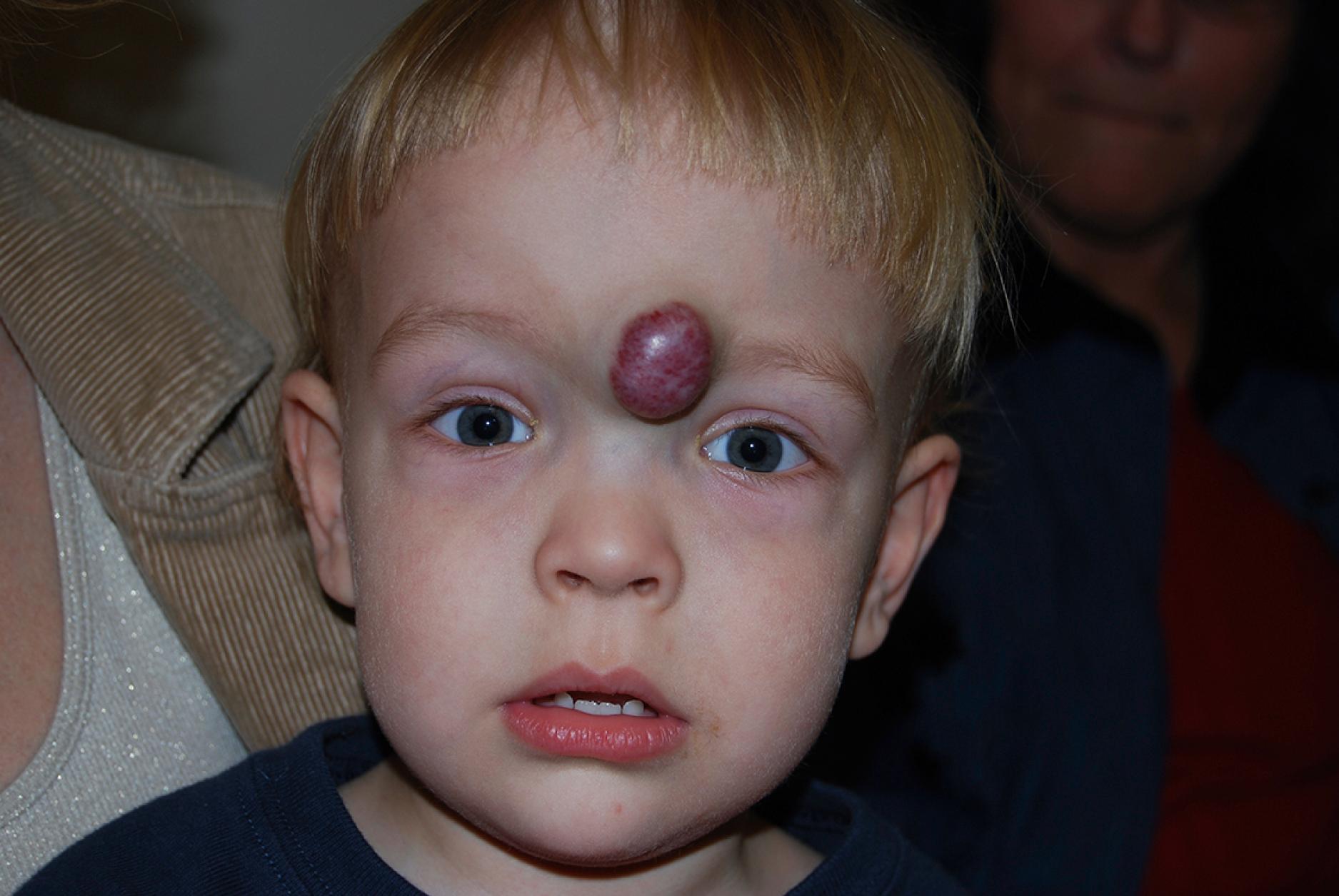
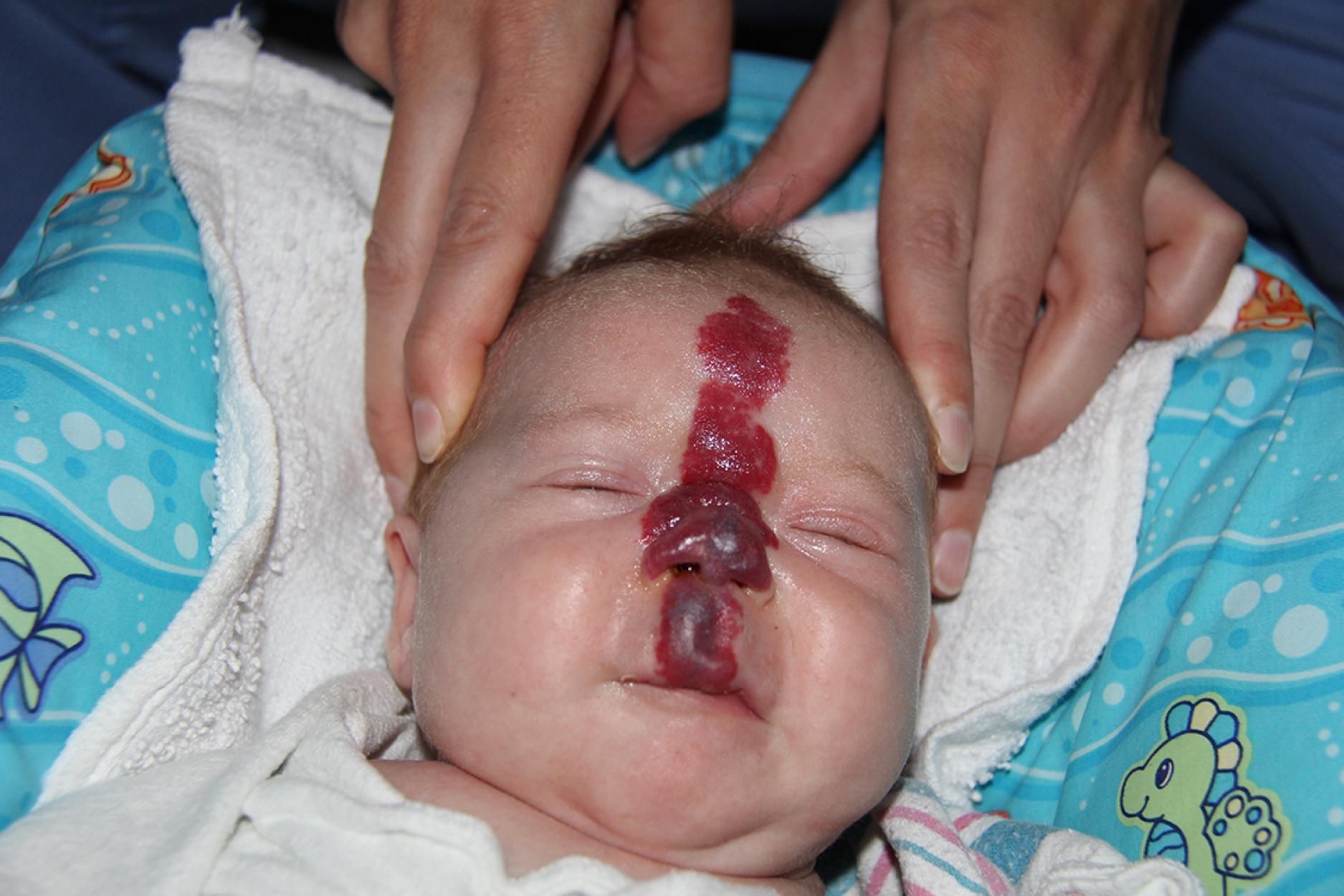
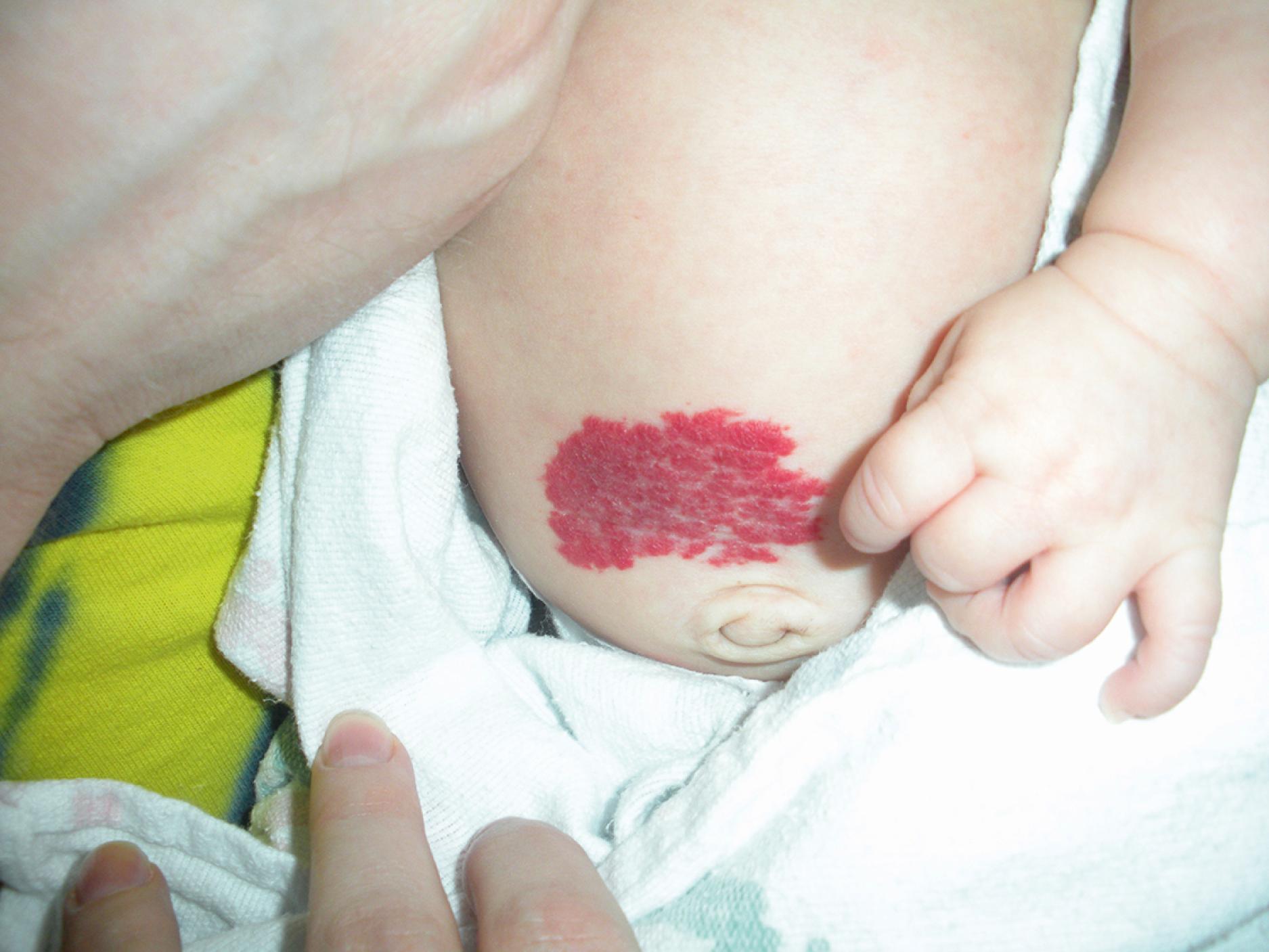
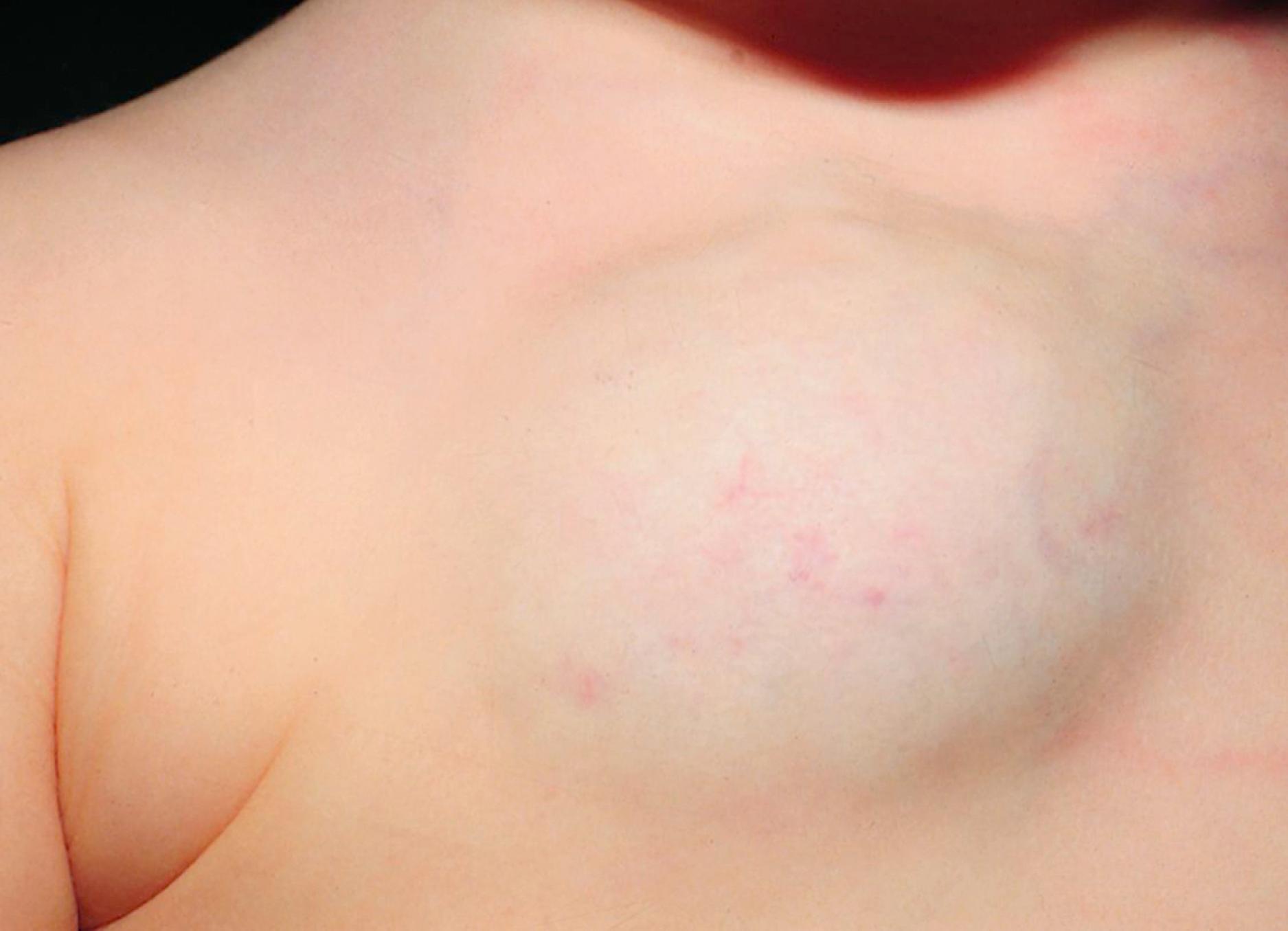
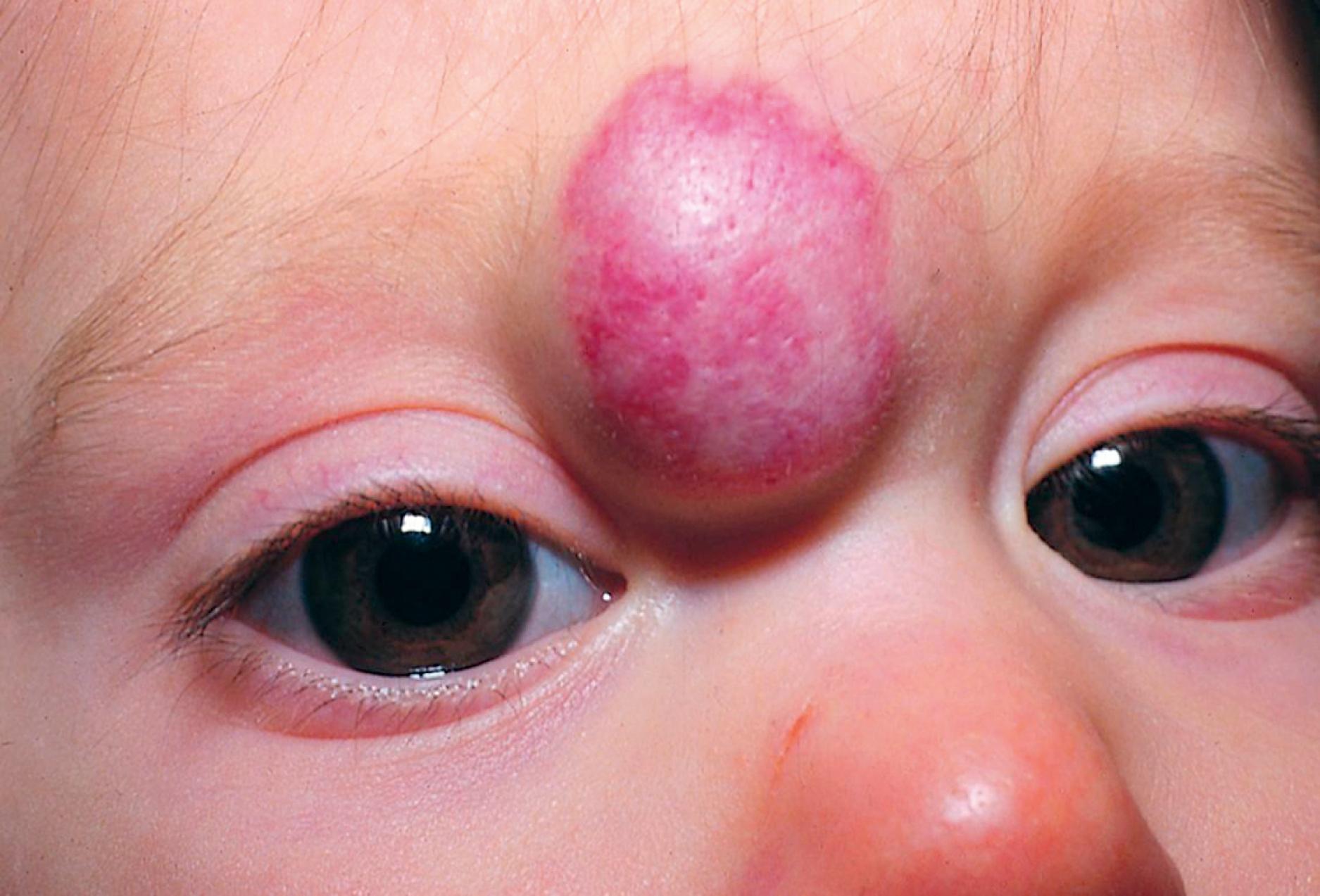
Third, the location may give the clinician clues to factors, such as risk of ulceration (perioral and perianal), associated anomalies (PHACES syndrome, beard distribution in subglottic hemangiomas, and LUMBAR syndrome), and risk of end organ injury (periorbital and periauricular). These relations will be described further later.
Fourth, size is important in that lesions greater than 5 cm have predominance toward complications. There are multiple complications associated with larger lesions, including an association with other congenital anomalies when located on the head and neck or in lumbar and pelvis region, risk for ulceration and bleeding, development of high output heart failure, and an association with consumptive hypothyroidism. When measuring the size of a single localized hemangioma, the clinician should evaluate the region of largest diameter, including both superficial and deep components. These measurements become more difficult when the infantile hemangioma takes on the form of a segmental hemangioma. The measurement of the lesion is based on the diameter of the most proximal edge of the string of islands to the edge of the most distal island.
Finally, progression is a description of the natural history of the hemangioma ( Fig. 10.6 ). Classically, infantile hemangiomas are described to have two stages in their life cycle: (1) rapid proliferation and (2) spontaneous involution. At birth, there is usually no noticeable lesion or a premonitory mark (pale macule with telangiectasias, mottled vascular stain, or bruise-like area). When a premonitory mark is present, this is usually described as a result of birth trauma (scratch or bruise) or a more common birthmark, such as nevus simplex. The rapid proliferation phase initiates at 1 to 4 weeks old in the superficial and mixed type, whereas deep type starts around 2 to 3 months old. Rapid proliferation is noted when the once absent or flat lesion has significant proliferation with growth in all three dimensions. The rapid proliferation stage can be broken into two sections: an early and late proliferation. The early proliferation stage is when noticeable growth can be seen from one day to the next and makes up the largest portion of total growth. Duration of the early proliferative stage is variable for each individual hemangioma but can be expected to last until 3 months of age. The average hemangioma achieves 80% of total size during this early proliferative stage. The late proliferation stage demonstrates a slowing of growth, with noticeable growth based on measurement from one week to the next but not by purely clinical observation. The late proliferative stage is once again variable in duration until 6 to 9 months old. Following rapid proliferation is a stage of slow involution. Classical teaching is that infantile hemangiomas will have spontaneous regression by 10% per year. Therefore 30% by 3 years, 50% by 5 years, and 70% by 7 years will have complete regression without intervention, but more recent studies demonstrate that the majority of involution occurs by 4 years of age.
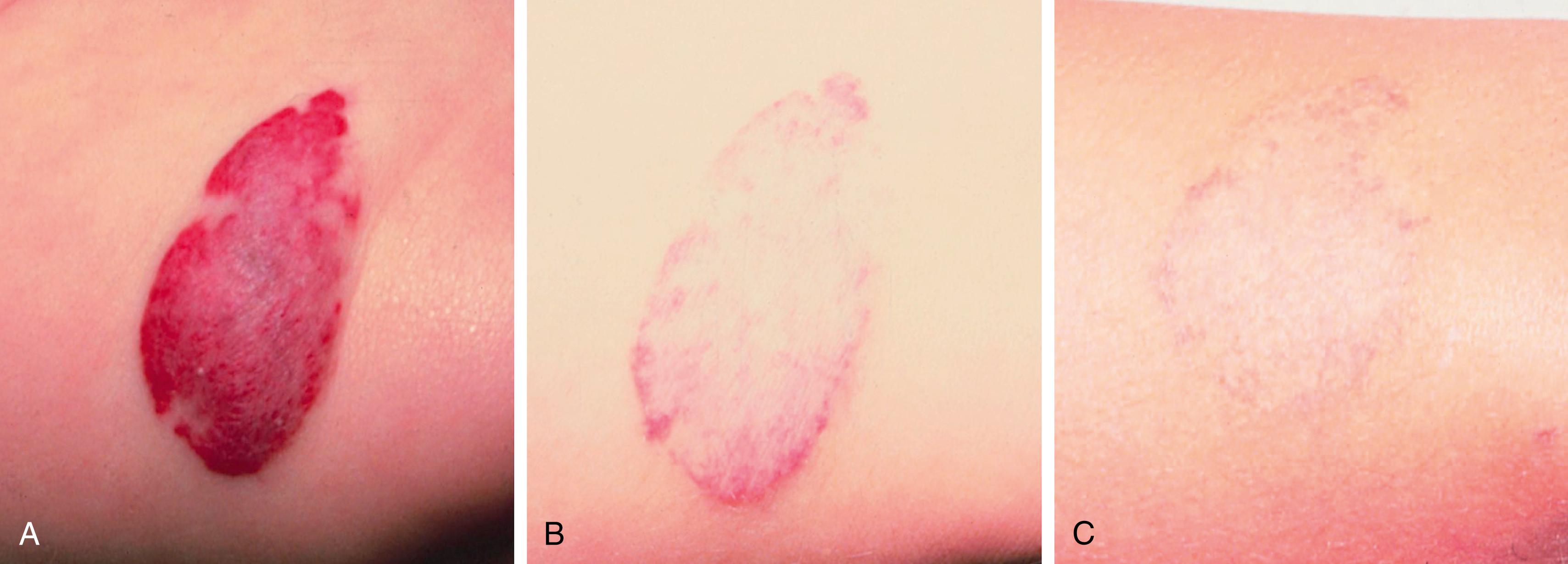
The majority of infantile hemangiomas are diagnosed clinically. Occasionally, deep infantile hemangiomas or extracutaneous may be difficult to diagnose and imaging can be helpful to distinguish from other neoplasms. Ultrasonography with Doppler study is the test of choice which demonstrates a well-circumscribed homogeneous mass with high-flow pattern characteristic of infantile hemangiomas. Magnetic resonance imaging (MRI) of infantile hemangiomas demonstrates a well-circumscribed, densely lobulated mass with an intermediate signal intensity on T1-weighted images and a moderately hyperintense signal on T2-weighted images Fig. 10.7 . Infantile hemangiomas will also show contrast enhancement on MRI. Rarely, if clinical and radiographic diagnosis cannot be made, the histopathology will be necessary. Infantile hemangiomas are composed of densely packed endothelial cells that form small capillaries and a histologic appearance of growth phase with plump endothelial cells in a lobular architecture. Immunohistochemical staining for glucose transporter-1 (GLUT-1) protein is positive in infantile hemangioma cells and is negative in other vascular anomalies.
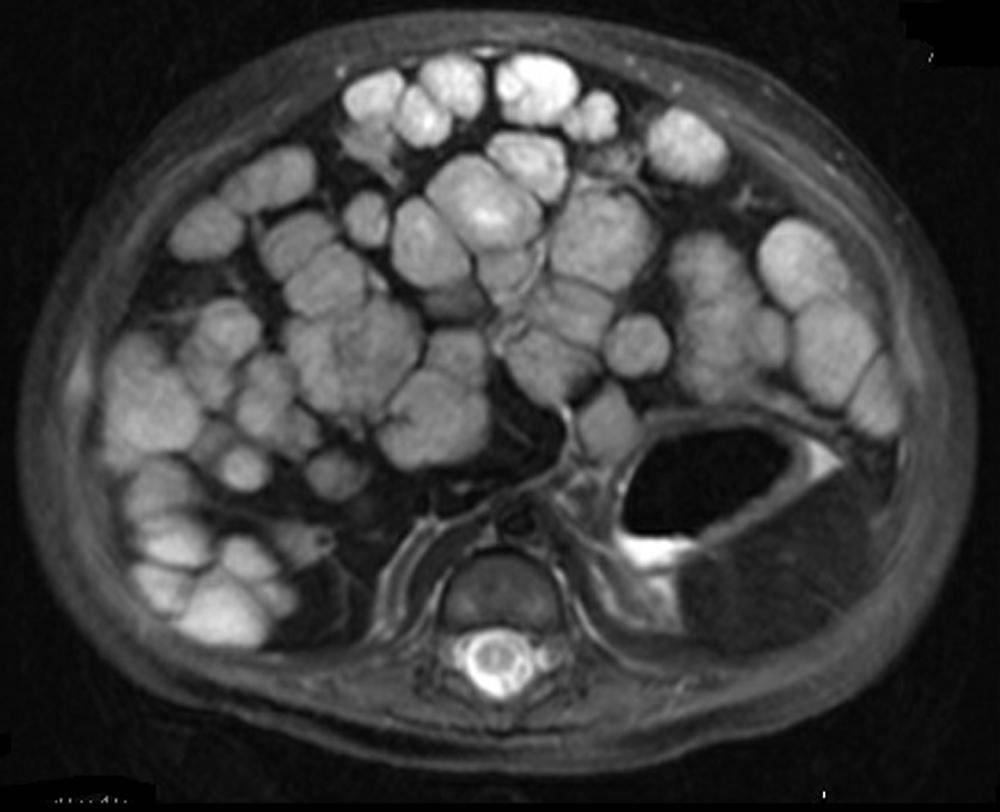
The most common complication of infantile hemangiomas is the development of ulceration ( Fig. 10.8 ), which occurs in approximately 15% of patients with infantile hemangiomas. The concern with the ulcerative hemangioma is the associated risk of bleeding, cosmetic deformity, and associated pain. Therefore the goal is to determine which lesion is high risk to institute early treatment and prevention of these negative outcomes. Once again, the size, quality, location, and progression of an individual hemangioma give the clues to early treatment. Infantile hemangiomas greater than 25 cm 2 in size have a clinically significant probability of developing ulcerated hemangiomas. The depth of the hemangioma demonstrated a profound predictor of ulceration in that 20% of mixed type hemangioma resulted in ulceration in comparison with 9% of superficial and less than 1% of deep. Furthermore, the segmental hemangioma had a 33% of ulceration in comparison with 7% of localized. By location, infantile hemangiomas of the lower lip, neck, and anogenital region are significantly more likely to ulcerate. Ulceration occurs 30% of the time on the lower lip, 25% of the time on the neck, and 50% of the time in the anogenital region. Ninety-five percent of ulcerations occur within the rapid proliferation phase, with only 5% occurring after 10 months old. This is further broken down in that 35% of ulceration occurs during the early proliferative stage, with the remainder occurring during late proliferation. In addition, the appearance of an infantile hemangioma can give a clue to risk of ulceration. The classically rapidly proliferating hemangioma is of a homogenous red plaque, but when ulceration is imminent, the appearance develops a central graying ( Fig. 10.9 ). This is an ominous sign of impending ulceration. Take note that central graying is a normal appearance of typical involution once rapid proliferation has ceased, but in a hemangioma that is still growing, this signals impending ulceration.
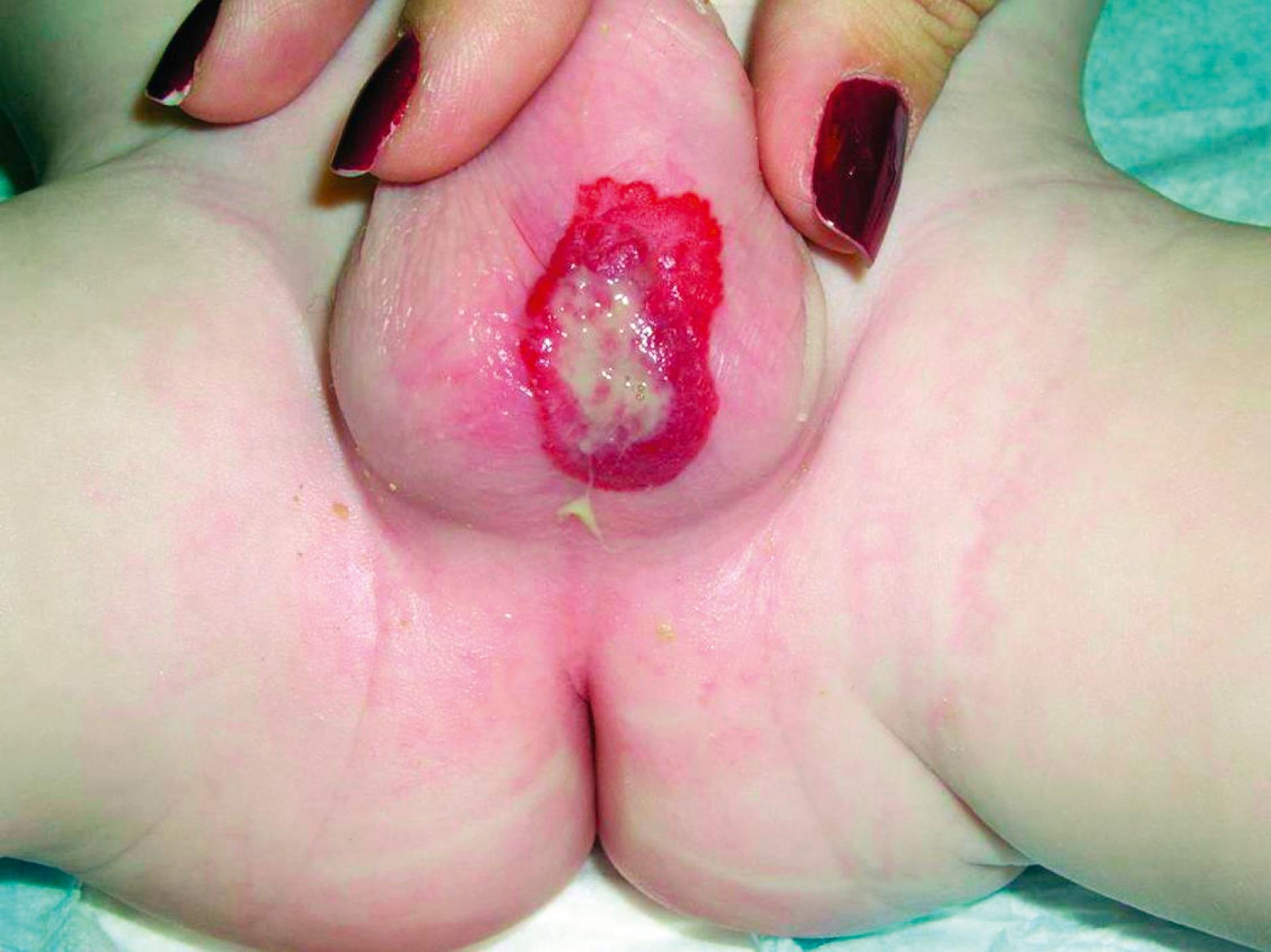
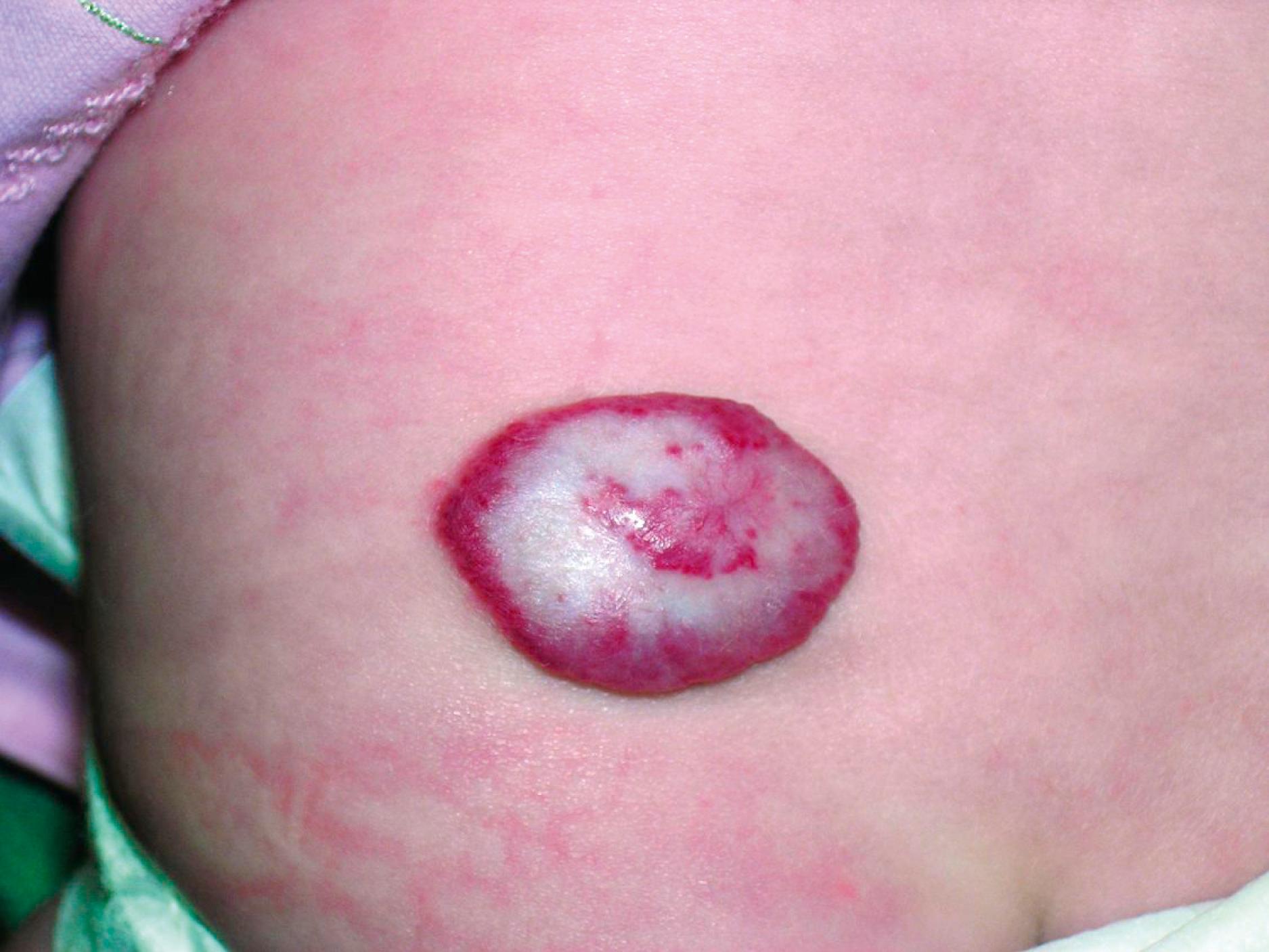
Periorbital hemangiomas ( Fig. 10.10 ) belong to an important class of hemangiomas that are at increased risk of end-organ injury. First, periorbital hemangiomas constitute 12% of all infantile hemangiomas and lead to some form of visual compromise in 41% of cases. The concern is development of amblyopia during a critical period of visual development. The initial visual impairment can occur by three mechanisms: (1) direct pressure on the globe leading to an induced astigmatism and therefore an asymmetric refractory error between the two eyes (anisometropia); (2) partial or complete occlusion of the visual axis; and (3) induction of strabismus due to the hemangiomas mass effect. These initial mechanisms of visual impairment can lead to permanent changes in visual development (amblyopia) if left untreated for 1 to 4 weeks. Therefore treatment of periorbital hemangiomas is a paramount concern. Of note, immediate evaluation of all periorbital hemangiomas is warranted by ophthalmology, but significant clinical warning signs of visual impairment would be hemangiomas more than 1 cm (size of iris), eyelid involvement, deep or mixed hemangioma, proptosis, ptosis, and medial location.

The presence of multiple cutaneous hemangiomas ( Fig. 10.11 ) has long been recognized as a marker for extracutaneous hemangiomas within the liver. Prospective studies have demonstrated that the presence of five or more cutaneous hemangiomas correlates with a 20% incidence of hepatic hemangiomas. Therefore the presence of multiple cutaneous hemangiomas (≥5) warrants evaluation with a liver ultrasound with Doppler to screen for intrahepatic hemangiomas. Recognition of these lesions early is important because large and multifocal hepatic hemangiomas (>5 cm) have arteriovenous shunts that can precipitate high-output congestive heart failure. Of note, an associated complication of multifocal and diffuse intrahepatic hemangiomas is a consumptive hypothyroidism. These hemangiomas produce an enzyme that catabolizes thyroid hormone and leaves the patient clinically hypothyroid. Therefore patients with multifocal or diffuse intrahepatic hemangiomas should be screened with thyroid function testing.
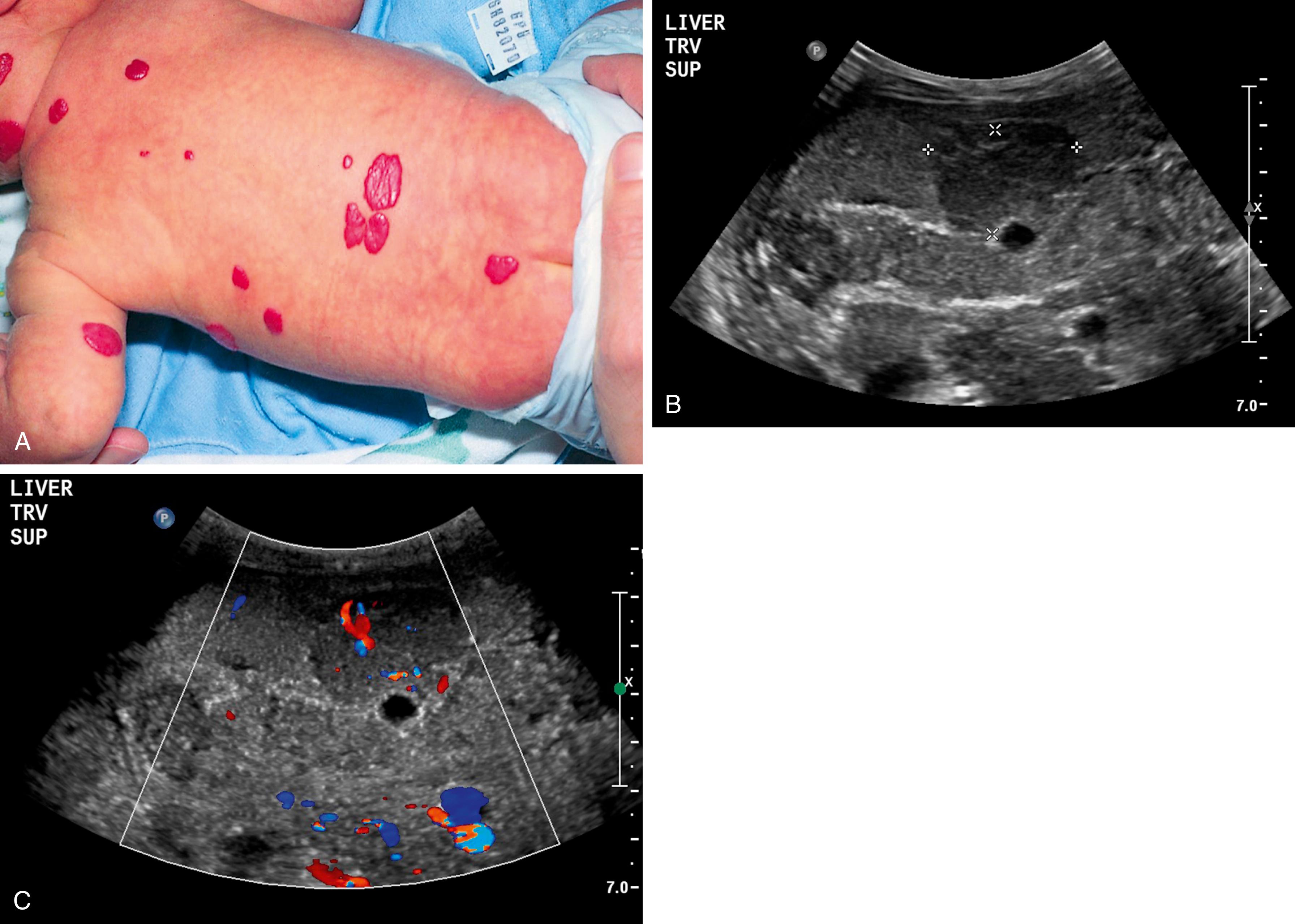
The location of a cutaneous infantile hemangioma can be a signal for other underlying anomalies. Hemangiomas over the lower face in the “beard” distribution have an association with airway hemangiomas 50% of the time and therefore warrant an airway evaluation ( Fig. 10.12 ). Along these lines, the presence of a segmental facial hemangioma has a strong association with PHACES syndrome. PHACES is an acronym for P osterior fossa malformation, H emangioma (>5 cm segmental facial hemangioma), A rterial anomalies of head and neck, C ardiac defects, E ye anomalies, and S ternal cleft ( Fig. 10.13 ). The hemangioma morphology of these lesions is described as segmental because they seem to cover a territory rather than arising from a single point. The more facial regions ( Fig. 10.14 ) that the segmental hemangioma covers will increase the likelihood of PHACES syndrome. These segmental hemangiomas are usually absent or subtle at birth but have rapid progression within the first few weeks of life. Initial appearance can be confused with a port-wine stain initially, because it will have red plaque-like appearance but will quickly differentiate as it rises from a macule on the skin surface to a plaque. The presence of a segmental facial hemangioma more than 5 cm warrants an evaluation for PHACES syndrome. Practitioners should obtain an MRI of the brain (evaluate posterior fossa malformation), magnetic resonance angiography (MRA) of the head and neck (evaluate cerebrovascular anomalies), palpation of femoral pulses, transthoracic echo (evaluate cardiac anomalies with coarctation of the aorta most common), physical exam of the chest wall to look for midline defects, and eye examination by pediatric ophthalmologist ( Table 10.1 ). In the same way, segmental hemangiomas of the lower body have associations with congenital anomalies of the spine, urogenital, arterial, anorectal, and renal systems and have been termed LUMBAR syndrome ( Fig. 10.15 ). Once again, any segmental hemangioma of the lower body more than 5 cm warrants further evaluation.
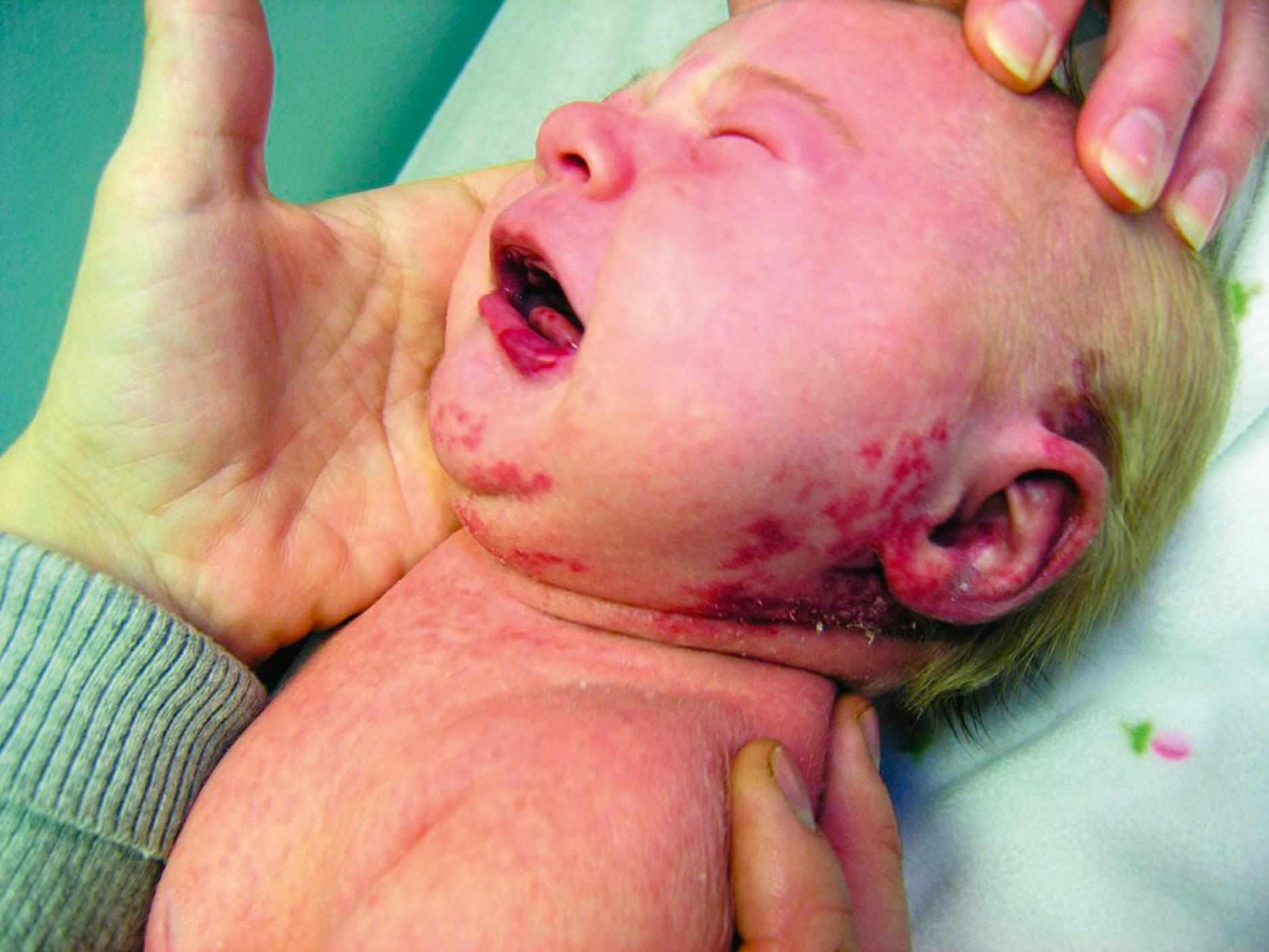
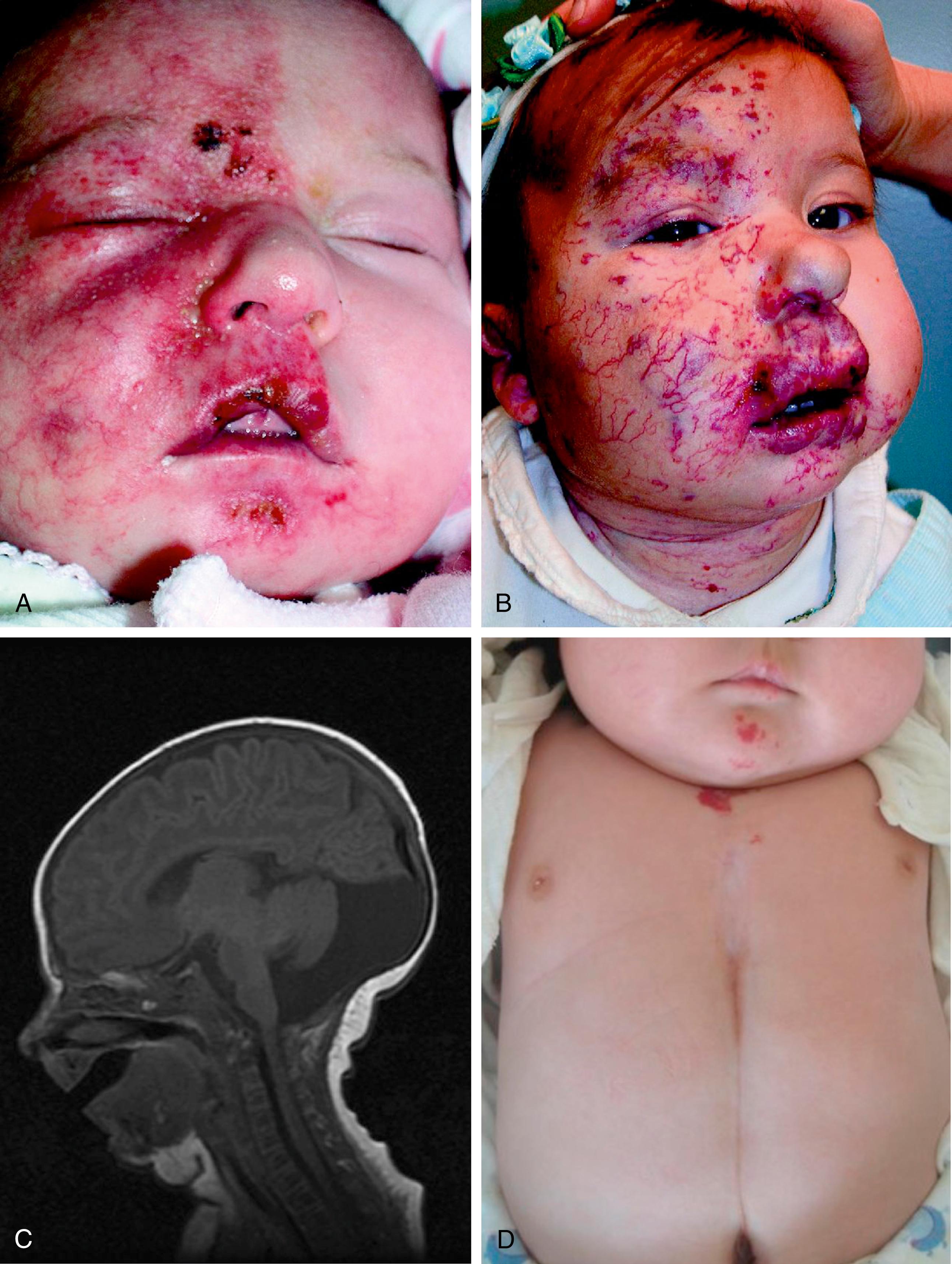
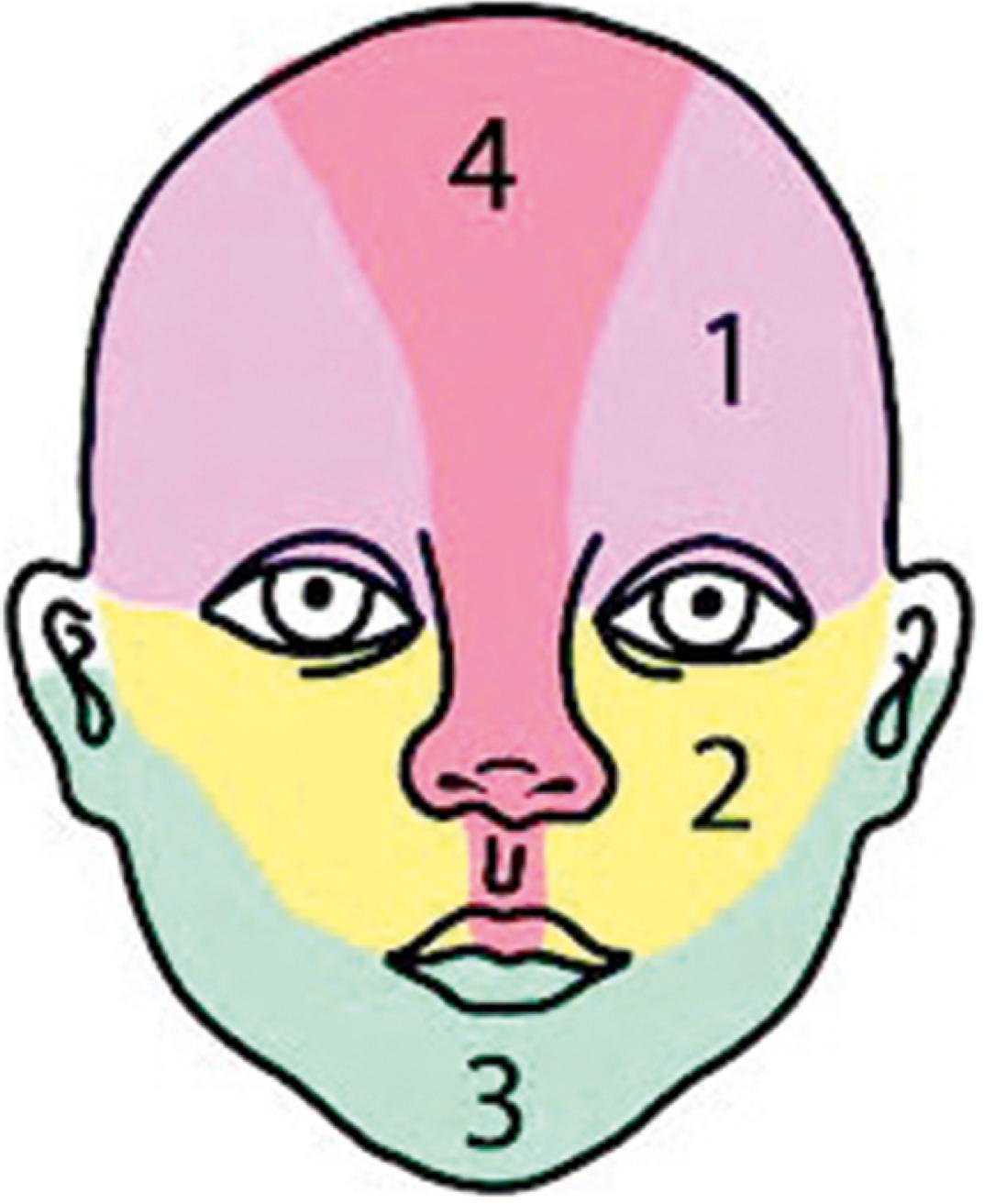
| Associated Anomaly | Screening Test |
|---|---|
| Posterior fossa anomaly | Brain MRI |
| Facial hemangioma | Clinical observation |
| Arterial malformation | MRA head and neck |
| Cardiac anomaly | Transthoracic echocardiogram |
| Eye anomaly | Ophthalmology consultation |
| Sternal anomaly | Clinical observation |
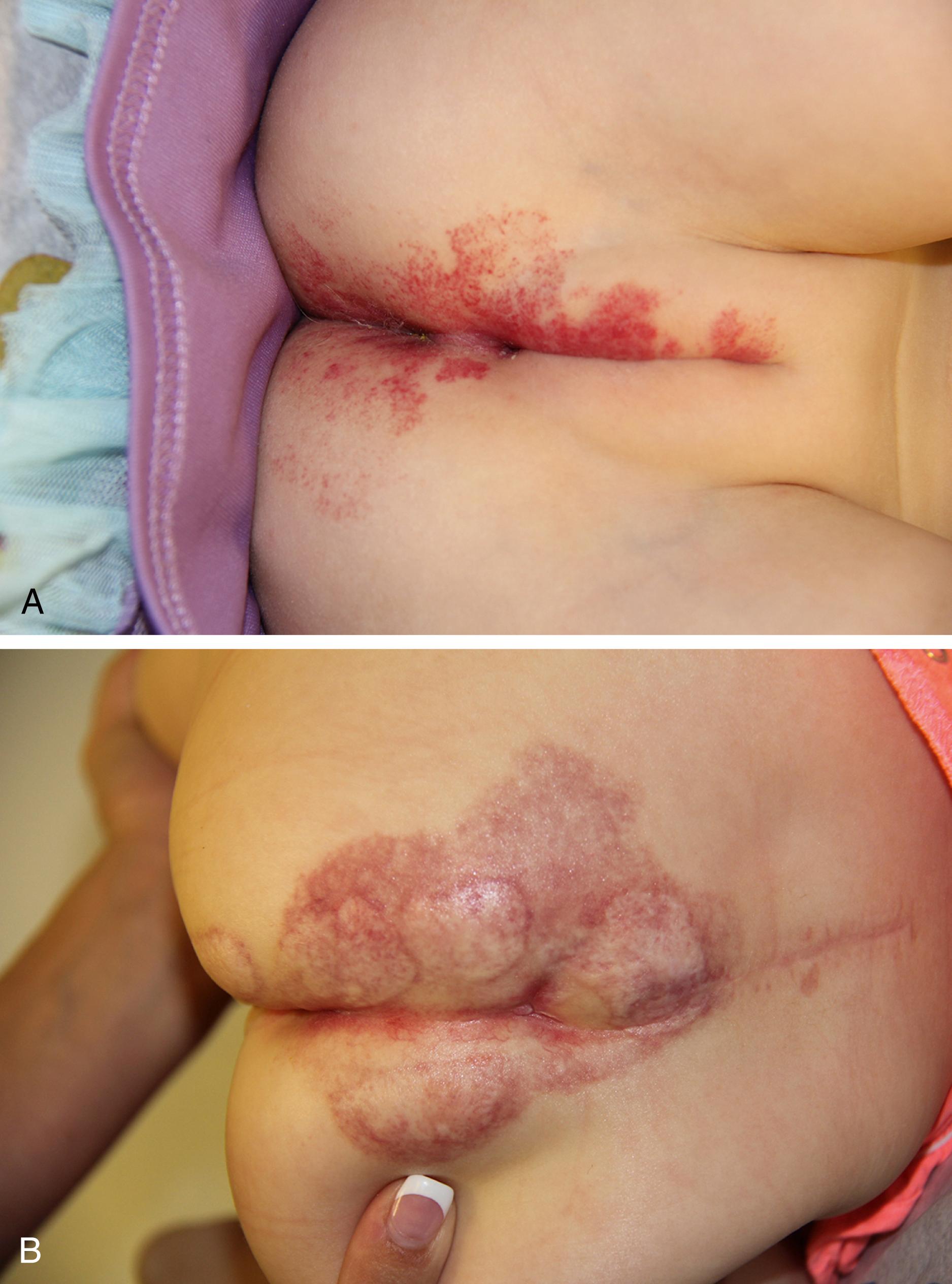
Although knowledge and understanding of infantile hemangiomas have grown dramatically in the past decade, this has been eclipsed by the change in management, because propranolol has become the main line treatment modality. Previously, corticosteroids, vincristine, and interferon alpha were the available treatment options. This all changed in 2008, when a case series published in the New England Journal of Medicine demonstrated the remarkable effectiveness of propranolol in treatment of this disease process. Since that time, multiple studies have supported this original finding, including a randomized control trial which has instituted propranolol as the first line treatment of infantile hemangiomas. The standard of care for high-risk lesion as described previously is for at least 6 months and until the first birthday. Recent studies have supported the utility of topical timolol maleate gel for treatment of thin (<2 mm in depth) lesions, therefore expanding the armament of treatment options.
The congenital hemangioma is an uncommon vascular tumor. Prominent features to distinguish the congenital hemangioma are that it is fully formed at birth and many times can be identified on prenatal ultrasound. The classical appearance is of a solitary plaque-like lesion with violaceous appearance. Lesions usually have coarse telangiectasias on the surface and a halo of blanched skin encircling the margins. Congenital hemangiomas can then be differentiated into three categories based on their life cycle. The first category is the noninvoluting congenital hemangioma (NICH) that never recedes ( Fig. 10.16 ). The second is the partially involuting congenital hemangioma (PICH) that will flatten in the first year of life but not completely recede. The final category is the rapidly involuting congenital hemangioma (RICH) that will completely recede in the first year of life and typically leaves behind a characteristic atrophied plaque ( Fig. 10.17 ).
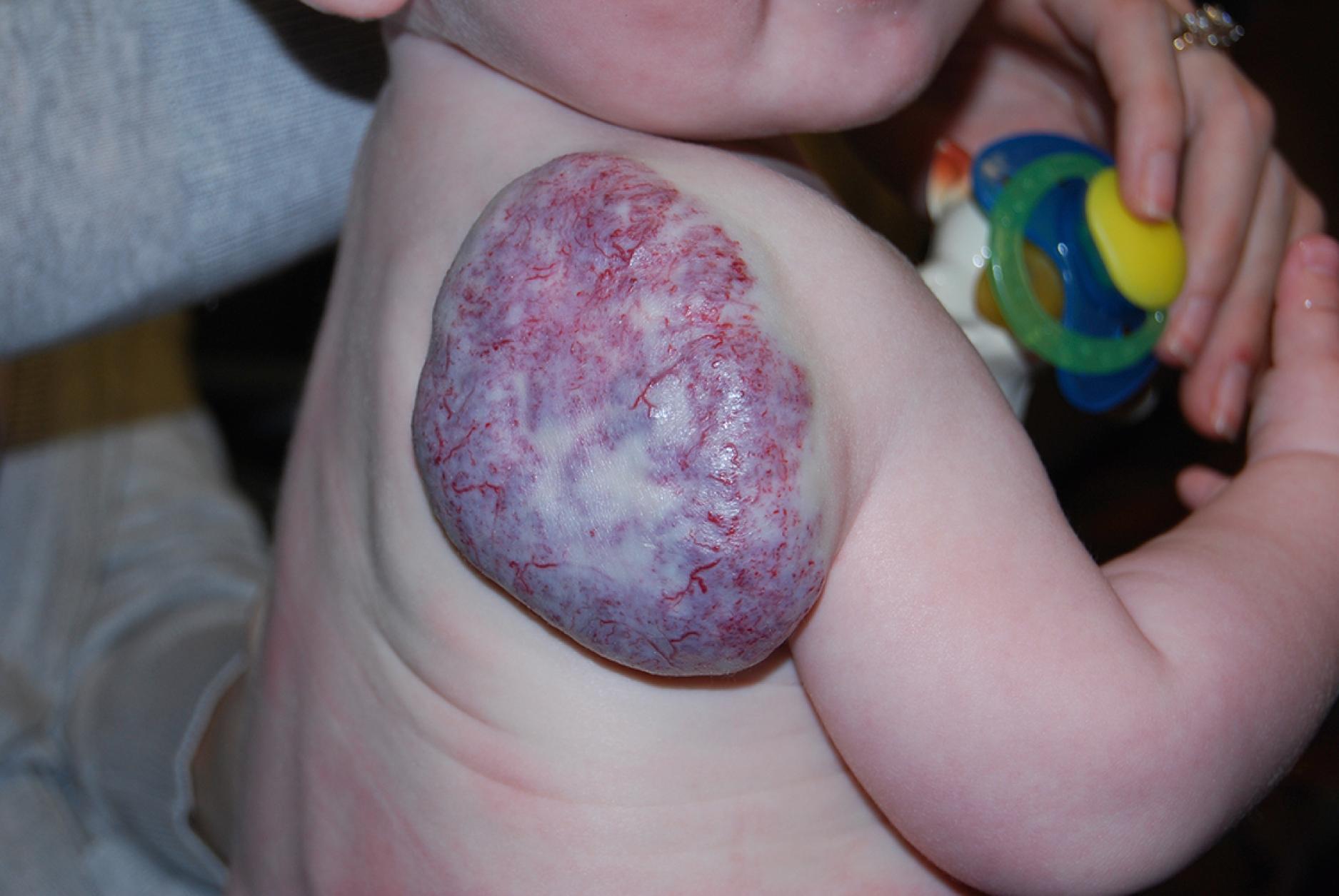
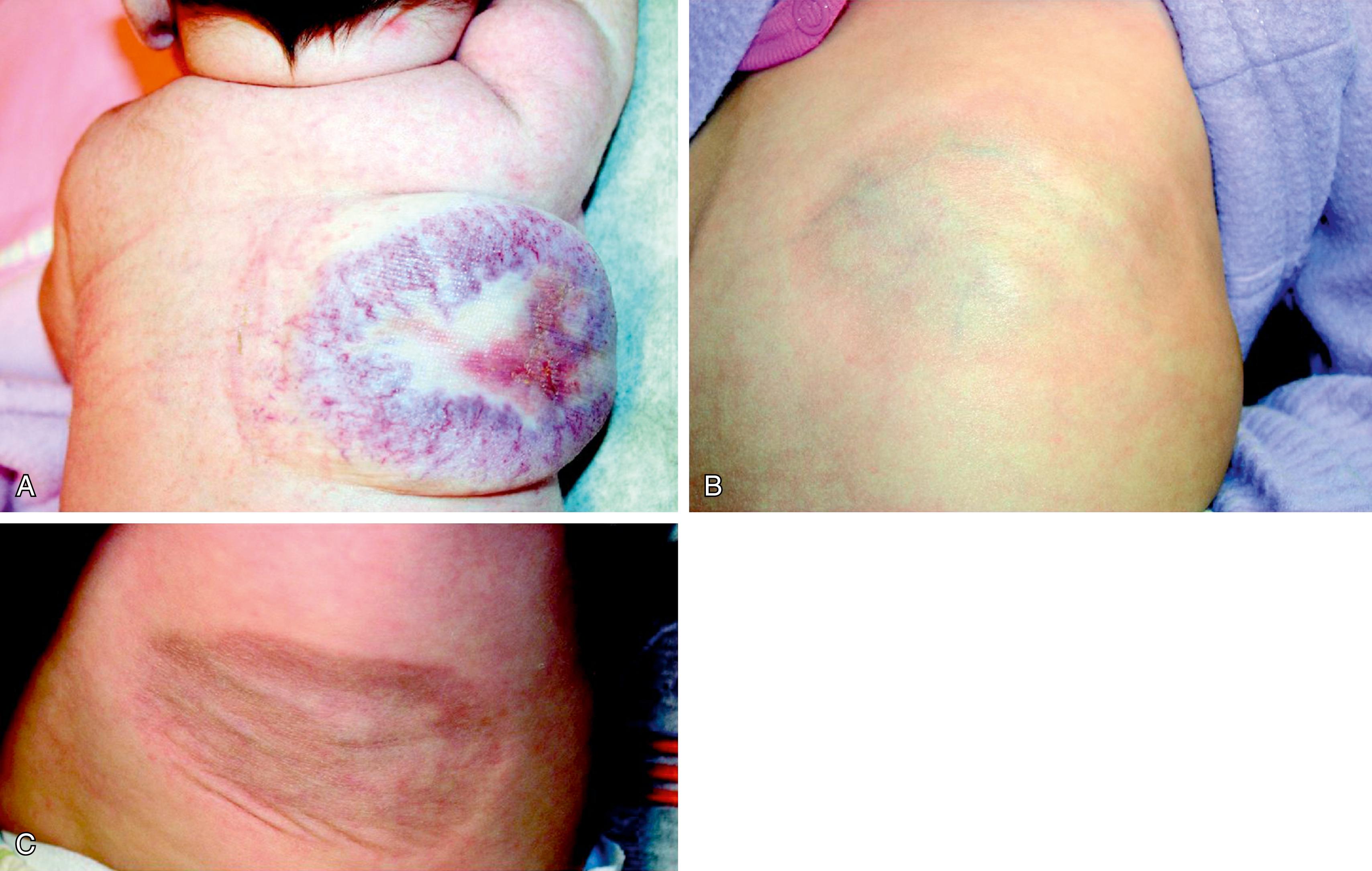
Pyogenic granulomas are common benign vascular tumors that resemble small hemangiomas. They are thought to stem from vascular overgrowth of granulation tissue following a minor trauma, or reaction to a foreign body, such as a thorn, splinter, or piece of glass. They consist of a solitary bright red, soft nodule that is often pedunculated with an average diameter of 5 to 6 mm ( Fig. 10.18 ). Their surface is friable and bleeds easily. Pyogenic granulomas are commonly confused with hemangiomas, but their onset after the newborn period allows for distinction.

Verrucous hemangiomas are a benign vascular tumor that initially resembles plaque-like infantile hemangiomas. They predominantly occur on the extremities. Initial appearance is in early infancy as a soft bluish red plaque that enlarges with time and can achieve a final size of 2.5 to 20 cm in diameter. They do not regress like infantile hemangiomas and instead develop a hyperkeratotic appearance to their surface ( Fig. 10.19 ). At times they can be complicated with bleeding. These lesions can only be treated with surgical resection.
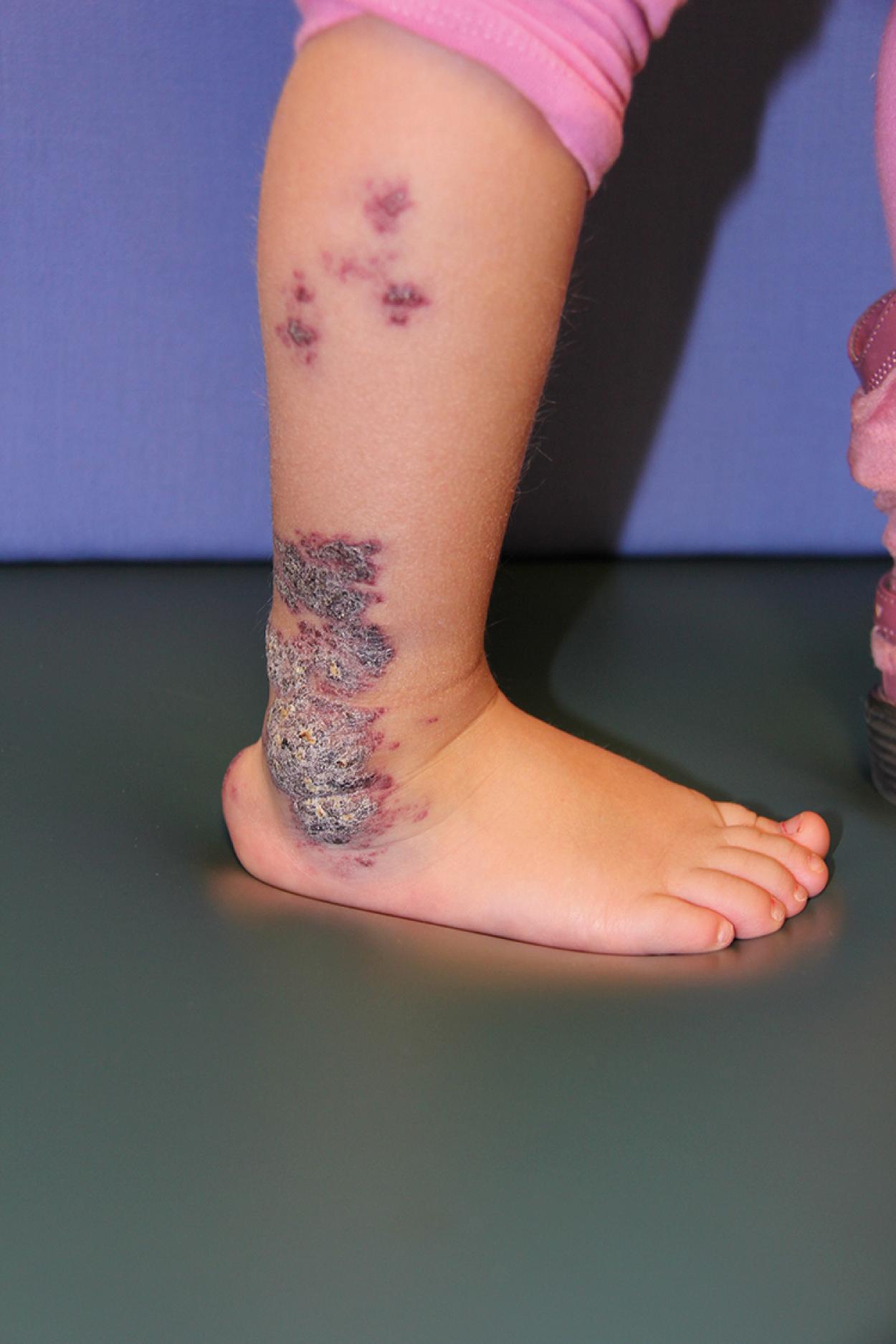
Become a Clinical Tree membership for Full access and enjoy Unlimited articles
If you are a member. Log in here